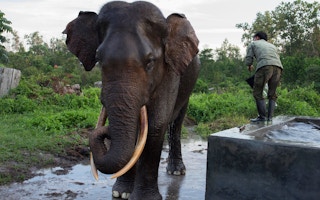Ramping up funding for indigenous and local communities - rather than just governments - to take the lead in protecting threatened forests could be key to boosting a stuttering global deforestation pact agreed last year, according to green groups.
More than 140 nations agreed to halt and reverse deforestation and land degradation by the end of the decade at the COP26 United Nations climate change summit in Glasgow, Scotland, late last year.
But with COP27 in Egypt just over a month away, progress toward achieving that goal has been too slow, forest analysts say.
The November climate conference could provide new momentum, however, if donors focus their spending on indigenous groups and communities living in protected areas, many of whom play a vital role in conservation, they added.
“We haven’t seen much implementation (of the Glasgow declaration) this first year,” said Kim Carstensen, director general of ethical standards body the Forest Stewardship Council.
At the Egypt summit - taking place in Sharm El Sheikh - Carstensen said he would like to see “countries come up with agreements to really work with those who are the stewards of the forests … particularly indigenous peoples”.
Worldwide, tropical forest losses amounted to 3.75 million hectares (9.3 million acres) last year, a rate equal to 10 football pitches a minute, according to satellite monitoring service Global Forest Watch (GFW).
“
Moving forward public and private resources must flow to the frontline defenders of nature and those best positioned to stop deforestation - indigenous peoples and local communities.
Brian O’Donnell, director, Campaign for Nature
Cutting down forests has major implications for efforts to curb climate change, as trees absorb about a third of the planet-warming carbon emissions produced worldwide.
Forests also provide food and incomes for people living in or near them, are an essential habitat for wildlife and regulate rainfall.
COP27 could offer a “breakthrough” if nations or a coalition of countries are able to find a way to convincingly demonstrate how to fund and work with indigenous peoples on forest conservation.
“Much of the funding or government interest so far has been on working with governments and in many cases creating … bureaucracies (rather) than solutions on the ground,” Carstensen said.
Frontline defenders
Earlier this month, Indonesia and Norway agreed on a new funding pact to cut carbon emissions by protecting and restoring rainforests in the Southeast Asian country. Yet conservationists criticised opaque wording on indigenous peoples’ rights.
Soon after, on the sidelines of the UN General Assembly meeting in New York, Germany pledged 1.5 billion euros ($1.44 billion) per year in international biodiversity funding — more than doubling its current commitments.
“Commitments like those being made by Germany are critical … but the how is just as important as the how much,” said Helen Tugendhat, a programme coordinator at the Britain-based Forest Peoples Programme, a rights group.
“The delivery of pledges like this must emphasise providing money closer to those who need it most, and in ways that empower rather than overwhelm local groups and communities,” she added.
About 195 nations are set to finalise an accord to safeguard plants, animals and ecosystems at a UN summit, known as COP15, in Canada in December.
But finance provided by rich countries to help developing nations meet the targets of the expected deal remains a challenging issue during negotiations, observers say.
Global annual spending to protect and restore nature on land needs to triple this decade to about $350 billion by 2030 and rise to $536 billion by 2050, a UN report said last year.
Brian O’Donnell, director of the conservation non-profit Campaign for Nature, said indigenous peoples and local communities had proven to be very effective at maintaining forests and safeguarding biodiversity.
Yet only a tiny percentage of global climate and nature finance has been directed to them, and this must change if the world is to meet its global climate and nature goals, he said.
“Moving forward public and private resources must flow to the frontline defenders of nature and those best positioned to stop deforestation - indigenous peoples and local communities,” O’Donnell said, adding that he welcomed pledges for increased finance for climate, forests and nature.
“Now it’s time to make those commitments count by steering funding to where it will be most effective, supporting indigenous peoples and local communities’ efforts to safeguard their territories,” he added.
This story was published with permission from Thomson Reuters Foundation, the charitable arm of Thomson Reuters, that covers humanitarian news, climate change, resilience, women’s rights, trafficking and property rights. Visit https://www.context.news/.








